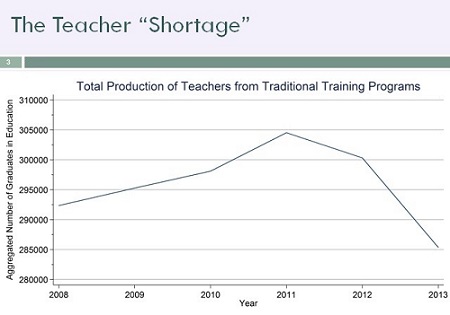Isn’t it amazing how someone or some things gain traction when the facts clearly aren’t on their side?
Just like the media handed off most of its airtime and column inches to elevate Donald Trump’s candidacy, so too is the media guilty of announcing a crisis in teacher supply when the facts just don’t support it.
While there are no data to suggest we are in the midst of teacher shortage, there are certainly school districts that are experiencing real problems—but they’re largely the same school districts which have been struggling for years, even in times the media was reporting big teacher layoffs.
There are some data to suggest that enrollment has dropped considerably in some teacher preparation programs in some states. But as we’ll show, it’s a big leap to say that the drop in enrollment means there won’t be enough teachers.
These two graphs from economist
Dan Goldhaber illustrate the importance of taking the long view.


This first graph does indeed
show that the number of new teachers produced since 2008 has declined. But keep
in mind that that drop was preceded by a
three-decade
period of enrollment growth
, far outpacing the demand year-in and year-out
(as the second graph shows). America’s 1,450+ institutions which train teachers
have been OVER-enrolling for years.
The current decline is what we
normally see when unemployment dips and the pool of folks looking for work
isn’t as large as in other years.
And as programs have not traditionally
seen it as their responsibility to direct candidates to shortage teaching areas
(e.g. special ed), there continue to be massive misalignment between the types
of teachers trained and the types of teachers public schools need to hire.
Most notably, programs have been
routinely graduating twice as many new elementary teachers as public schools
hire each year.
Even when confronted with these
facts, many districts have begun to panic. In part they have grown accustomed
to dealing with a pretty distorted labor market and the low quality of many
teacher candidates. They’re used to having to sort through a pile of resumes to
find a single good hire. They are also often not nimble or flexible enough to
adapt their recruiting and hiring practices to a tighter job market.
What then is a reasonable response to a
downturn in teacher production? It’s not
to open the floodgates and let just anyone teach. We need to continue to
encourage teacher prep programs to become more selective and do a better job
preparing new teachers so that districts don’t have to count on 20 resumes to
find a single qualified teacher.
Districts would do well to tap
into the enormous pool of the many hundreds of thousands of people who were
certified to teach but never did. Some estimates put the percentage of new
teacher graduates who don’t actually teach at 50 percent. Neither states nor
districts make it easy for those folks to reconsider the profession a few years
down the road.
More like this

From Patchwork to Precision: Strengthening Teacher Data Systems

Trained but sidelined: how schools are missing out on mid-career teachers

Teacher layoffs loom large. How to lessen the blow
